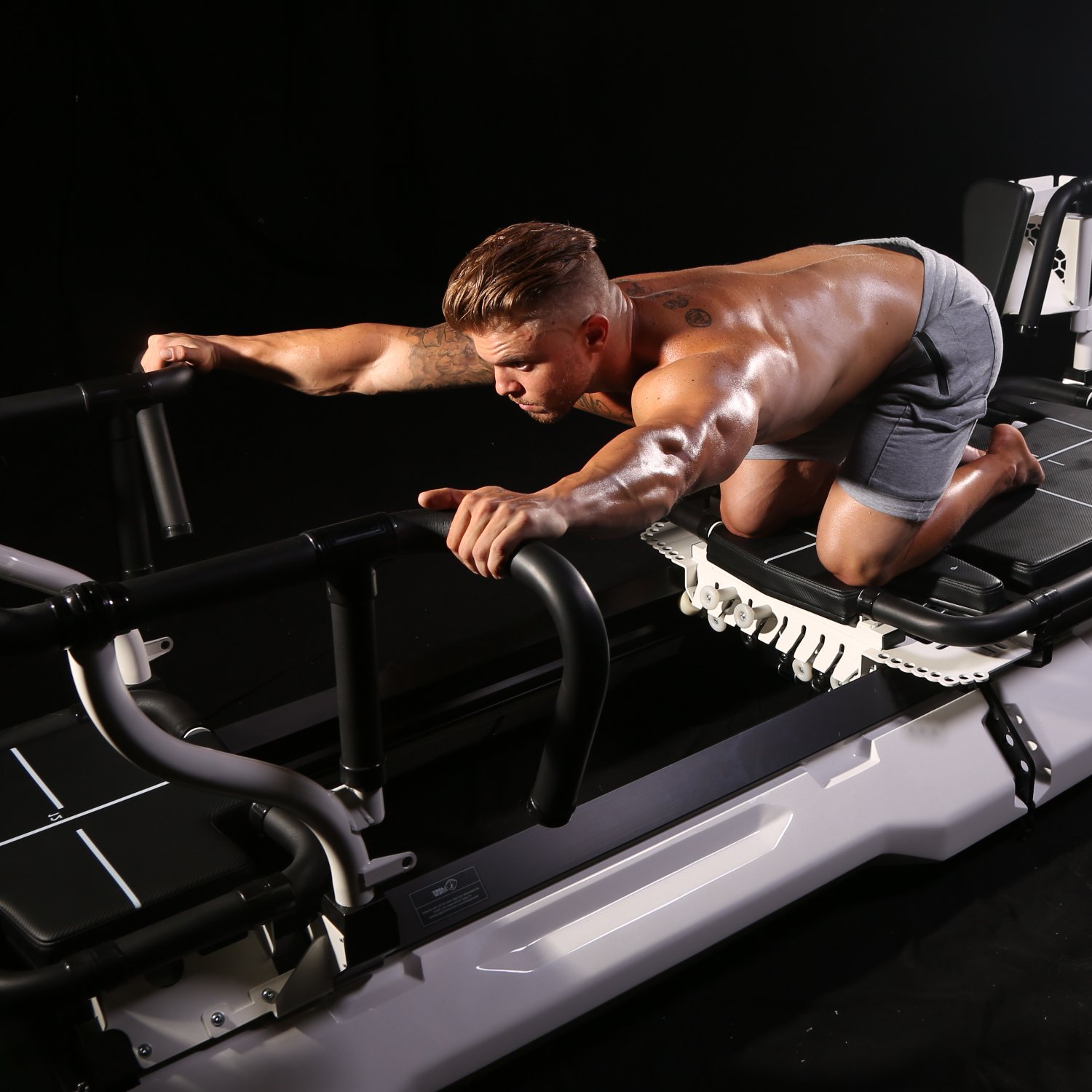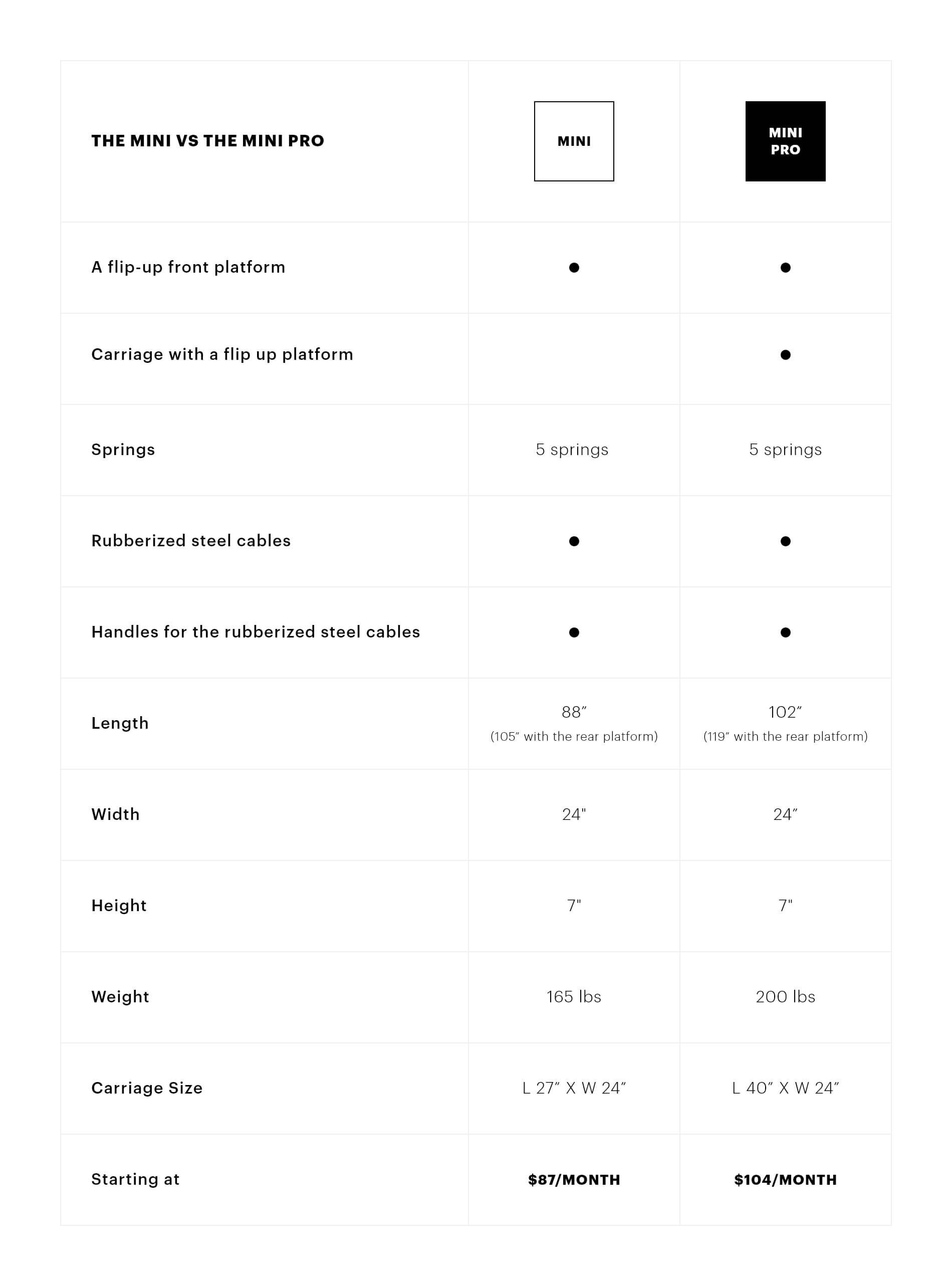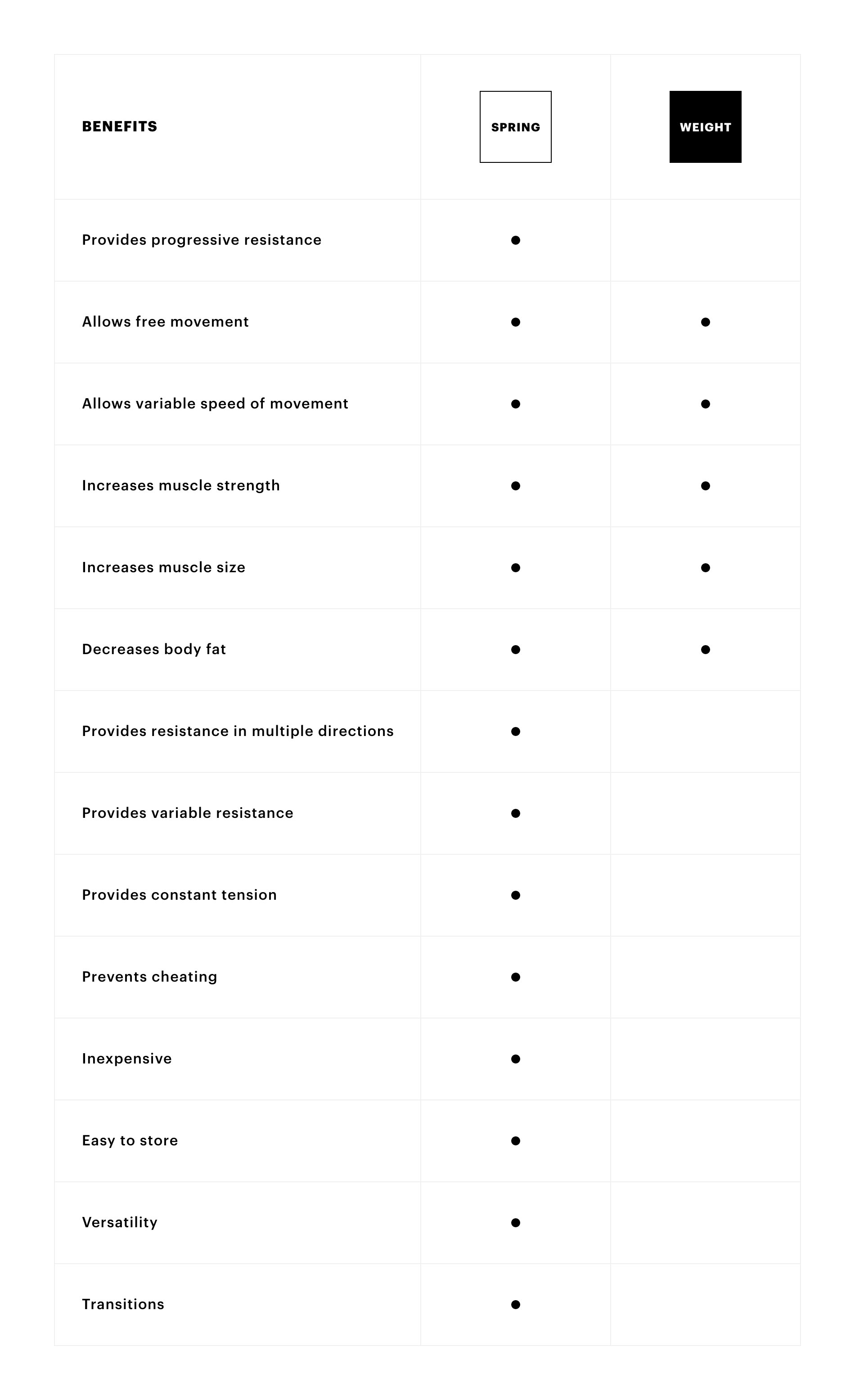LAGREE SPRINGS VS WEIGHTS
VARIABLE TENSION VS STATIC TENSION
At Lagree Fitness, the science behind our method and machines is persistently evolving—and that is because Lagree Fitness is altering how fitness is imagined, pursued, and achieved. One of the major elements that differentiates Lagree Fitness from any other type of exercise (in this case, we will draw specific differences between Lagree Fitness and weightlifting) is spring resistance vs free-weight resistance.
SPRINGS CONVERSION
THE SIMILARITIES
Both spring resistance and free-weight resistance (produced when training with barbells and dumbbells) have the following properties in common:
1. Both provide resistance
2. Both allow for free range of motion
3. Both allow for variable speeds of movements
4. Both stimulate muscle and bone mineral density growth
These four properties are critical to enjoying the benefits of effective resistance training programs. Despite the similarities between spring resistance and free-weight resistance, however, many fitness enthusiasts assume free weights are superior, but this could not be further from the truth.
WHAT IS
SIMILAR
THE DIFFERENCES
In addition to the similarities spring resistance training shares with free weight resistance, there are several benefits to spring resistance training that the latter does not offer.
- Spring Work on Both Vertical and Horizontal Planes
- Allows Change in Muscle Emphasis
- Provides Continuous Tension
- Offers Linear Variable Resistance
- Prevents a person from “cheating”
SPRING RESISTANCE CAN WORK ON BOTH VERTICAL AND HORIZONTAL PLANES
Unlike free weights, spring resistance does not rely on gravity to provide resistance. This increases its potential for use in more functional movement patterns that mimic both everyday activities and sport-specific activities. Because free weights rely on gravity, they can only provide resistance in a vertical plane—the direction of gravity. This means that if an exercise with a free weight is performed on a horizontal plane, such as moving a dumbbell from one side of the body to the other, there is no resistance to that movement. With springs, on the other hand, resistance is also formed when doing exercises in a horizontal plane.As such, exercises such as twisting the body from side to side, side kicks and punches, as well as movements that mimic a baseball swing or basketball pass by using spring resistance, can be effectively performed with spring-based training. In fact, performing exercises with resistance in a horizontal plane better prepares an individual for performing daily tasks, such as turning the body while carrying a heavy box, in a much easier manner that also decreases the risk for injury. For athletes, it better prepares them for competitive movements that take place on a horizontal plane, such as swinging a baseball bat. This type of training is considered highly effective for preventing sport injuries.

SPRING RESISTANCE ALLOWS CHANGE IN MUSCLE EMPHASIS
Because spring resistance does not rely on gravity to provide resistance, it is possible to alter the emphasis placed on the muscles during certain exercises. This is made possible by changing the direction of the pull.
The ability to change muscle emphasis is important for those who want to target specific muscles, either for aesthetic reasons or to add strength for sports competitions. It is also important for those with injuries, as shifting the force more to certain muscles can help protect certain associated joints. For example, greater hamstring emphasis during squatting or stepping exercises helps to protect certain structures around the knee. This is difficult to accomplish with free weights because, as previously stated, they require the direction of force to be vertical due to their reliance on gravity for resistance.

SPRING RESISTANCE PROVIDES CONTINUOUS TENSION
Because spring resistance does not rely on gravity, it provides continuous tension which increases the rate at which muscles can be trained.
When a dumbbell is lifted in any direction other than straight up and down, the tension on the muscle can actually be removed at certain points in the range of motion. For example, when doing a bicep curl with a dumbbell, as the dumbbell curls up towards the shoulder, at the very top of the movement, the dumbbell is literally falling towards the shoulder. This means that the tension on the bicep has been removed because the dumbbell is no longer being lifted up against gravity by the bicep. When doing a bicep curl with spring resistance, the tension is present throughout the entire range of motion because the spring provides resistance both up and down due to its innate properties.

SPRING RESISTANCE OFFERS LINEAR VARIABLE RESISTANCE
Unlike spring resistance, free-weight resistance does not offer linear variable resistance. This means that as the range of motion of the exercise increases, the resistance provided by the spring equipment increases. For example, when doing a bicep curl, as the hand is curled up toward the shoulder, the resistance of the elastic tubing increases. This is due to the physical properties of the spring itself. As its length increases (from being stretched), it provides more resistance. One of the benefits of this is that as the range of motion increases and the resistance increases, thus the number of muscle fibers being used in the exercising muscles increases as well. The more muscle fibers being used, the greater the adaptations in muscle strength that can be achieved with the training program. This benefit is not offered by free-weight resistance.Yet another reason linear variable resistance is beneficial is due to what is known as the strength curve of muscles. The linear variable resistance provided by springs better mimics the strength curves of most muscles. A strength curve refers to the way a muscle or muscle group’s strength changes during a range of motion. Because of their anatomy, most muscles increase in strength throughout the range of motion until a certain point. Again, using the biceps curl as an example: As the hand is curled toward the shoulder, the muscle gets stronger up until about the halfway point of the range of motion. Thus, the muscle is weakest at the start of the exercise and strongest at the halfway point of the exercise. When doing a biceps curl with a free weight, the individual is limited as to how much resistance they can use by how strong the bicep is at the beginning of the exercise (its weakest point). That means that during the bicep curl, the muscle is not receiving adequate resistance when the muscle is at its strongest point in the range of motion. When performing a curl with spring resistance, the resistance increases as the range of motion increases. This means the muscle receives greater resistance at its strongest point in the range of motion and is therefore receiving more adequate resistance to better stimulate strength adaptations. Many individuals who train using spring resistance report they feel a significant difference, such as a stronger burn in the muscles and greater muscle fatigue, compared to when they use free-weights. This is due to the linear variable resistance that the spring resistance equipment offers. This allows a greater number of muscle fibers to be used and taxed throughout the range of motion. Anecdotal evidence aside, research confirms this difference.

SPRING RESISTANCE PREVENTS A PERSON FROM "CHEATING" DURING AN EXERCISE
In short, spring resistance prevents the user from “cheating” during the exercise being performed. This is a critical benefit addressing a common practice seen during the use of training with free weights. Cheating involves the use of momentum to initially move the weight. Once the weight has built up momentum, the muscle fibers do not need to be maximally activated to continue moving the weight throughout the remaining range of motion of the exercise. This is because the physics of momentum have taken over to move the weight.Quite the reverse, the physical properties of spring resistance devices do not allow the user to cheat by using momentum. This is because the resistance from the elastic equipment comes from the stretching of the spring material and not the mass of the elastic equipment. The only way to continue a movement while performing an exercise with spring-resistance is to utilize more muscle fibers in the exercising muscle to continue stretching the spring.

THE SUPERIORITY OF SPRING RESISTANCE TO FREE-WEIGHT RESISTANCE
Research performed on spring resistance suggests that not only does spring resistance offer similar benefits to free weight resistance, but this form of exercise contains several benefits that outweigh (*pun intended*) those of free weights. A program using spring resistance can provide similar benefits to a program that uses free-weight resistance, such as increased muscle strength, increased muscle tone/size, and lower body fat. This changes body composition in dramatic, noticeable, and lasting ways.
TRY LAGREE NEAR YOUA FINAL
NOTE




